Jackson Coppley's Blog, page 3
December 20, 2024
Top Quality Thrillers for Free

I am happy to announce my participation in a great give-away for the season.
December 4, 2024
Camino Ghosts by John Grisham
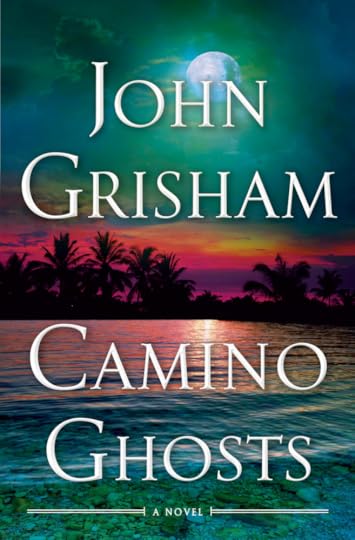
"Camino Ghosts" is the third installment in John Grisham's Camino Island series, following "Camino Island" and "Camino Winds." The novel intertwines elements of legal drama, historical fiction, and mystery, set against the backdrop of a small island community.
I listened to the audio version of the novel, which had the additional treat of having Whoopi Goldberg performing the narration.
Plot Summary:
The story begins with author Mercer Mann returning to Camino Island for her wedding to Thomas, with the bookseller Bruce Cable officiating the ceremony. Seeking inspiration for her next novel, Mercer learns from Bruce about Dark Isle—a deserted barrier island off the Florida coast, steeped in history and rumored to be cursed. The island was once home to a community of runaway slaves, and its last surviving descendant, Lovely Jackson, claims ownership despite lacking formal title deeds. As developers eye Dark Isle for a massive resort, Mercer and Bruce become involved in a legal battle to preserve the island's heritage and support Lovely's claim.
The beginning of the book is especially compelling in describing the slave trade. Lovely Jackson’s ancestor Nalla was among the survivors of a slave ship that wrecked near the island in the 18th century. After the ship sank, she and other survivors made their way to Dark Isle, where they formed a small colony. Nalla's legacy is central to the novel, as she is believed to have placed a curse on the island to protect it from outsiders.
We may all know the story of the slaves’ harsh voyage across the Atlantic. It has been told many times. But, “Camino Ghosts” tells Nalla’s story from the time her village was raided and she was taken captive. That is a story less told.
The courtroom scenes provide the legal drama Grisham is known for, while the rich historical context offers a fresh perspective within the genre. However, there is more detail on the court maneuverings than this listener cared for. Grisham seemed not to resist calling on his lawyering roots.
However, "Camino Ghosts" is a compelling addition to the series, blending mystery, history, and legal intrigue in a narrative that is both thought-provoking and entertaining.

October 26, 2024
“Ask the Dust”–Book versus Movie
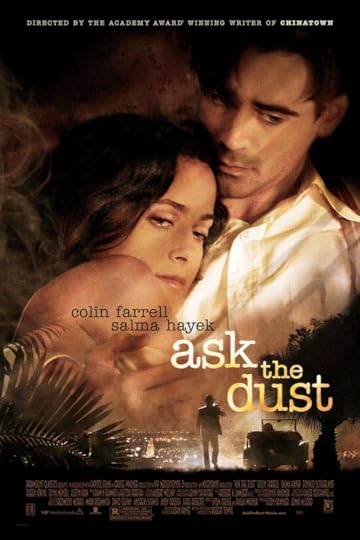
You may remember I previously spotlighted John Fante in another newsletter, including a review of his novel “Wait Until Spring, Bandini. I just finished reading his second book, “Ask the Dust,” and followed it up by watching the 2006 film adaptation starring Colin Farrell as Arturo Bandini and Salma Hayek as Camilla.
It’s always intriguing to see how a film reshapes its source material.
But first, what’s “Ask the Dust” about?
Set in 1930s Los Angeles, the novel follows Arturo Bandini, the eldest son from “Wait Until Spring, Bandini.” After getting a story published in a magazine, Arturo believes he's destined for literary greatness. He moves to L.A. and rents a dingy room in a run-down hotel built on a hill. The building is so oddly situated that Arturo finds it easier to enter his room through the window than the door.
Arturo encounters Camilla, a waitress at a nearby dive. Their relationship begins on a toxic note—Arturo berates her over curdled cream in his coffee, mocks her shoes, and disparages her for being Mexican. This despite having experienced prejudice himself for being Italian. Yet, despite the insults, both the book and film make it clear that Arturo is drawn to her.
For much of the movie, the filmmakers remain faithful to the book, lifting dialogue and scenes straight from the text. Of course, some moments are trimmed for brevity, but the film captures the essence of Fante’s narrative. Donald Sutherland plays an excellent role as Arturo’s war-damaged neighbor, a man never quite the same after being gassed in World War I. Idina Menzel, in an early screen appearance, portrays another love interest—long before her breakout role in “Frozen” made her famous for singing “Let It Go.”
The film diverges most notably in its portrayal of Arturo and Camilla’s relationship at the beach house. In the novel, Camilla leaves quickly to reunite with Sammy, another man she’s involved with. The movie, however, extends their time together, adding depth to their romantic connection.
The biggest difference lies in how the two versions handle Camilla’s fate. While the movie leans into a tragic, “La Bohème”-style ending, with Camilla dying of consumption, the book leaves her wandering aimlessly into the desert, her fate ambiguous.
I think I like the movie ending better. Score one for Hollywood.
October 22, 2024
Nick and Nina's Honeymoon Adventure

Love and Intrigue in Nicholas Foxe and the Lost Gold of Pompeii

What starts as a romantic honeymoon in Italy quickly turns into a thrilling journey for Nicholas and Nina Foxe. As they explore ancient ruins and decode cryptic clues, the couple uncovers secrets buried beneath the ashes of Pompeii. They find themselves in a dangerous race against time to recover a treasure worth killing for.
At the heart of the story is the dynamic relationship between Nicholas, a brilliant cryptographer, and Nina, his fearless and clever wife. Together, they must rely on trust, wit, and the strength of their new marriage to survive the perils they face.

Dressed for exploration, they navigate ancient streets and hidden paths, uncovering cryptic clues that hint at the legendary lost gold of Pompeii. With every discovery, the excitement builds, What began as a romantic getaway quickly turns into a high-stakes treasure hunt, where each step brings them closer to an unimaginable fortune hidden beneath the ashes of history.

A tantalizing clue points Nick and Nina to a reclusive collector with a passion for rare artifacts—and opera. Sensing an opportunity, Nina devises a bold plan to orchestrate a “chance” encounter. The target? The prestigious La Scala, where the collector is certain to attend. With elegance and purpose, they don their finest attire, blending into the glamorous crowd of opera enthusiasts. But beneath the glitz, they are on a mission, playing a high-stakes game of intrigue, where every glance and gesture could bring them closer to unlocking the next piece of the puzzle—or risk exposing their hand too soon.
Nicholas Foxe and the Lost Gold of Pompeii
Perfect for readers who love a blend of romantic suspense, historical intrigue, and adventure, this novel will sweep you away to Italy’s sun-soaked streets, ancient ruins, and luxurious villas.
Join Nicholas and Nina on an unforgettable journey—because some treasures are found not just in history, but in the bonds we build along the way.
Learn More:
September 10, 2024
Eruption by Michael Crichton and James Patterson
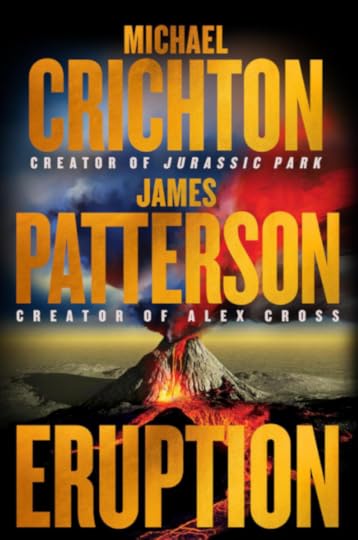
Eruption is a thriller that takes place on the Big Island of Hawaii. The main character, John MacGregor, heads the Hawaiian Volcano Observatory monitoring the volcano Mauna Loa. Mac and his team predict an imminent eruption of the giant volcano that could destroy vast areas of the island.
Oh, by the way, Mac is let in on the fact the army has stored secret containers of highly radiative herbicides in a lava tube within Mauna Loa. For the reasoning the army chose this site, the reader must suspend disbelief. Accepting it means these stored toxins could spread over the world if the volcano blows, bringing death and destruction to the entire world.
So… the stakes are high.
The book has much scientific description that sometimes bog down the narrative. When the action begins, this reader had a hard time visualizing in the stage direction what was north, south, east, and west when the lava flowed. I found it best not to try and let the fast-paced action envelop me.
Michael Crichton began working on “Eruption” before his relatively early death in 2008 at age 66. Best remembered for “The Andromeda Strain” in 1969 and “Jurassic Park” in 1990, Crichton was working on “Eruption” as a passion project for years before his death. His wife, Sherri, discovered boxes and boxes of research, along with a partial manuscript. She eventually chose James Patterson to finish the novel. The research was so scientifically dense that Patterson hired a researcher in Alaska to help weed through it.
The book shows the aforementioned scientific description that bogs down the narrative. However, James Patterson adds his magic to make it an enjoyable read.
Recommended

August 28, 2024
Resurrection Walk by Michael Connelly
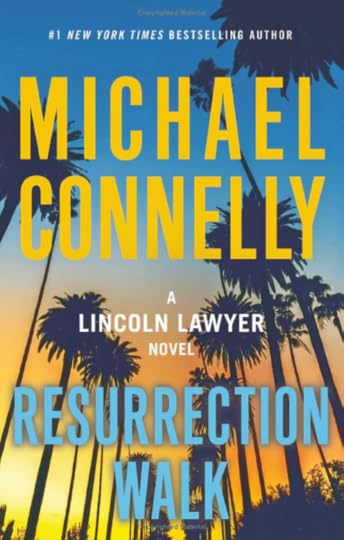
"Resurrection Walk" is the latest installment in Michael Connelly's Lincoln Lawyer series, featuring attorney Mickey Haller and his half-brother, retired LAPD detective Harry Bosch. This series fame with Matthew McConaughey portraying Haller on the big screen. (I’ve always been curious about why Haller operates out of his car, but more on that later.)
The novel starts with Haller successfully exonerating a man who was wrongfully convicted, which leads to a flood of letters from others seeking his help. Bosch, with his seasoned detective instincts, helps Haller sift through these pleas. One case catches their attention: Lucinda Sanz, who is serving time for allegedly murdering her husband, Roberto, a sheriff's deputy. Despite her conviction, and the fact she pleaded nolo contendere, Lucinda insists she is innocent.
As Haller and Bosch delve into the case, they uncover troubling aspects of the original investigation:
- There is evidence suggesting that someone may have framed Lucinda.
- Indications that the sheriff’s department rushed to judgment.
- Signs of corruption within the department.
- Roberto's possible involvement with a rogue group within law enforcement.
The novel’s second half shifts to the courtroom, where the interactions between Haller, the judge, and the opposing attorney create an engaging legal drama.
Connelly enhances the story by alternating the narrative perspective between Haller and Bosch, keeping the reader engaged with a lively pace.
Highly recommended.
As for why Haller works out of his car: In the early days of his career, Haller didn’t have an office, so he made do with his car. Even with his current success, he prefers the flexibility and comfort of his mobile office, albeit a Lincoln Navigator.

August 24, 2024
The Book of Elsewhere
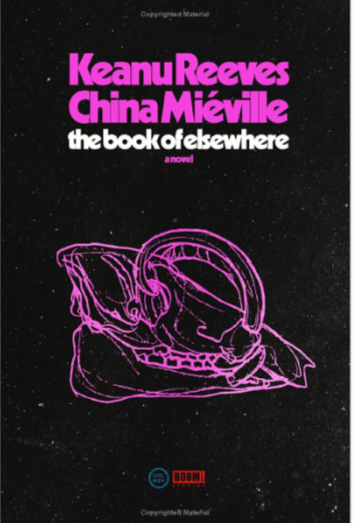
I saw Keanu Reeves on The Late Show where he talked about his new novel, “The Book of Elsewhere,” he wrote in collaboration with China Miéville. So, I bought the audio version, put it in the car player for a road trip, and immediately regretted the purchase.
The story is about a character known as “B,” who has lived for 80,000 years. He is working with a black-ops group, for reasons that are not clear. His nemesis is a prehistoric pig known as the “deer-pig.”
Are you with me so far?
The book received extreme mixed reviews. I liked the review that called it a “word salad.” However, I grant China Miéville as a poetic writer. That alone on a scale of one-to-five stars makes it a two-star book in my opinion.
A kinder review says, “The Book of Elsewhere is characterized as a unique and innovative work that seeks to explore profound themes through a lens of thrilling action and mythological storytelling.”
Whatever…

July 28, 2024
“James” by Percival Everett
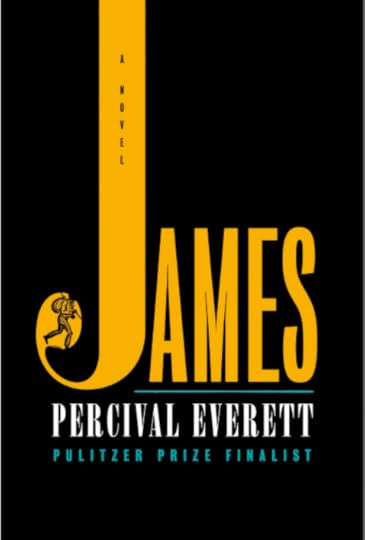
"James" by Percival Everett is a reimagining of Mark Twain's classic, "The Adventures of Huckleberry Finn," told from the perspective of Jim, the enslaved character who accompanies Huck on his journey.
Note: Readers may find the printed version of this novel challenging because of the narrative's attempt to write the articulation of the antebellum South. I listened to the audio version expertly portrayed by Dominic Hoffman, a noted voice and stage actor. He brought the language to life.
Set against the backdrop of the Mississippi River region during the early Civil War period, "James" shifts the timeline from Twain’s original 1830s setting to a more tumultuous era when the Civil War was about to begin. This change allows Everett to delve deeper into the themes of freedom and survival. Jim, who is running to avoid being sold and separated from his family, narrates his story.
Readers of "Huckleberry Finn" will find the same adventures and colorful characters in "James," but with a fresh perspective. Everett's portrayal of Jim is a significant departure from Twain's depiction. In this telling, James is a self-taught reader who councils enslaved children in how to talk among themselves and how to talk before white people.
"James" explores the intersection of language, race, and storytelling. Everett uses Jim's narrative to critique and expand upon the racial stereotypes present in Twain’s original work.
Although the book is faithful to the original story, as it concludes, it diverges significantly. Without spoiling the ending, let us just say, if James were a movie, the bad guys get their comeuppance.
Readers and critics widely praise the novel for its eloquence and the depth of its reimagining. Critics have noted that Everett's genius lies in maintaining the essence of Twain’s plot while infusing it with his own nuanced storytelling. "James" is a masterwork that stands on its own, offering new insights into one of American literature's most enduring stories.

June 30, 2024
Wait Until Spring, Bandini by John Fante
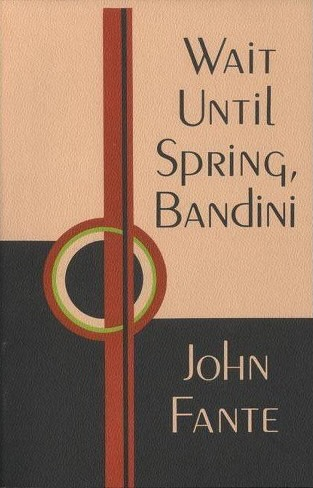
I was not familiar with the works of John Fante until a friend of Ellen’s (you know who you are) said his books were among his favorites. So, I began with his first in his series about an Italian immigrant and his family.
The Bandini family live in Colorado during the 1920s. Fante was born in Denver in 1909, so the author is writing about a time and place he knows well.
Svevo Bandini is the father, a mason and bricklayer. He’s out of work since there is little demand for his skills in the winter with snow covering everything. I assumed the title of the novel was drawn from that situation, but I was wrong. It has to do with his oldest son, fourteen-year-old Arturo, who’s a baseball fan, waiting for spring.
The other members of the family are Arturo’s younger brothers, August and Federico, and his mother Maria.
There are several themes and dramas in the family written in beautiful prose from each member’s point of view. The family faces severe financial hardships, but Svevo, the father, disappears for days on end leading up to Christmas. It is a mystery that tortures Maria, especially after she spots her husband riding in a car with the rich widow in town. That takes us down a path casting Svevo as a scoundrel, but we learn later we may draw the wrong conclusions.
That is only one theme of the book, at 266 pages, a rather short read. Others are Arturo’s coming of age (He’s smitten by a girl in his class), the social isolation as Italian immigrants, and the influence of Catholicism in the family.
I thought of the social themes of John Steinbeck in Fante’s writing. Svevo says, “The banker who owned that house was one of his worst enemies. The mental image of that banker’s face made his heart pound with a hunger to consume itself in violence. Helmer, the banker. The dirt of the earth.” I could just see the banker’s taking the land from the Okies in “The Grapes of Wrath.”
However, Fante is more lyrical in his prose than Steinbeck.
Like Ellen’s friend, I’m becoming a Fante fan.

June 15, 2024
The Demon of Unrest by Erik Larson
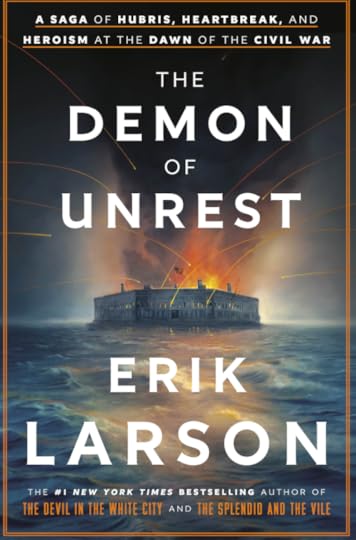
Erik Larson has hooked me on his writing since I read "The Devil and the White City." Larson has a unique ability to breathe life into historical events and their key figures.
In "The Demon of Unrest," Larson explores a critical five-month period from Abraham Lincoln's election to the fall of Fort Sumter. Unlike many historians who focus primarily on Lincoln and his inner circle, Larson brings to the forefront lesser-known individuals.
One such figure is Major Robert Anderson, the Union commander at Fort Sumter and a former slave owner. Another is Edmund Ruffin, a fervent secessionist who, despite his age, ensures he remains at the center of the action.
Readers might recognize Mary Chestnut, whose diary entries featured prominently in Ken Burns' PBS “Civil War” series. As the wife of a wealthy planter, Chestnut provides a detailed chronicle of the conflicts surrounding slavery.
Larson also highlights William Seward, Lincoln's Secretary of State. Known post-war for "Seward's Folly" in purchasing Alaska, Seward plays a significant role in the efforts to prevent the war.
Through vivid storytelling, Larson captures the tragic mistakes, intense rhetoric, selfish ambitions, and personal losses that characterized this turbulent era. His work offers a sobering view of how a polarized political climate led the nation into a devastating civil war.
Note: I read the book on a Kindle. When I reached 55% complete, the story was over. The rest were notes, as expected from a historian.




